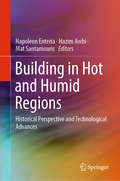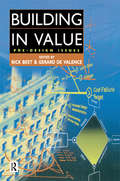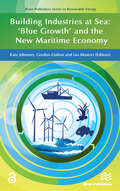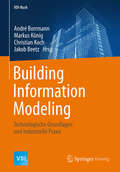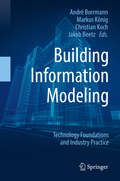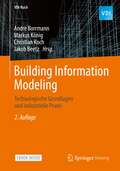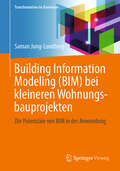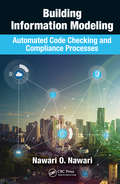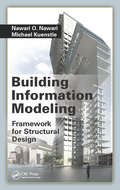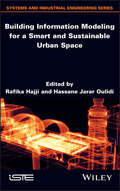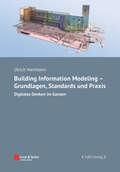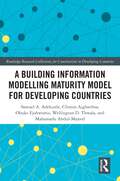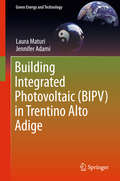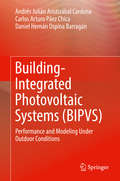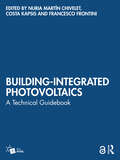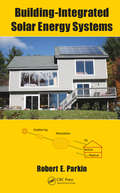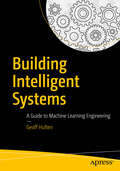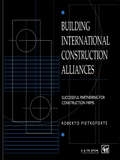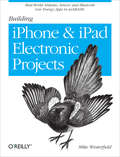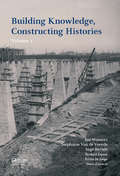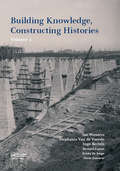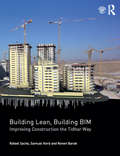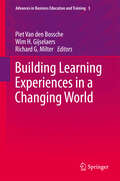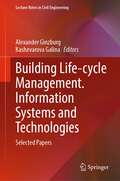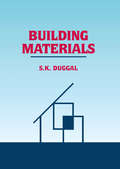- Table View
- List View
Building in Hot and Humid Regions: Historical Perspective and Technological Advances
by Napoleon Enteria Hazim Awbi Mat SantamourisThis book presents an in-depth analysis covering climatic and weather conditions, house and building development history, construction methods and technologies, and environmental conditions. It provides relevant house and building information and highlights recent advances in hot and humid regions, as well as developments in other regions that are relevant to hot and humid climates. The countries in hot and humid regions, which include the tropical countries, the Middle Eastern countries around the Mediterranean, and many countries of Central Asia and Africa, are home to some of the most challenging conditions in the world in terms of house and building design and construction, and in terms of maintaining indoor thermal comfort and air quality in an energy-efficient way. The book’s respective chapters, prepared by expert contributors, cover essential concepts, designs, and construction methodologies for houses and commercial buildings. As such, the book offers a valuable resource for undergraduate and graduate students in architecture and engineering, house and building designers, and building sciences researchers. Building contractors, manufacturers and distributors of building equipment and devices, and government policymakers and legislators will also benefit from the information provided in this book.
Building in Value: Pre-Design Issues
by Rick Best Gerard De ValenceThe concept of value in projects is a key issue for everyone involved in the construction industry. Building in Value brings together many experts in the field to outline the wide range of tools, techniques and procedures that can and should be used to make the building procurement phase as efficient as possible. The authors go on to discuss how to ensure that future problems in the design and construction of the buildings are anticipated at the start and to minimise the liklihood of future hiccups. Integrating strategic, financial and construction management techniques, this book provides an essential guide for construction professionals.
Building Industries at Sea - ‘Blue Growth’ and the New Maritime Economy
by Kate Johnson Gordon Dalton Ian MastersThroughout the world there is evidence of mounting interest in marine resources and new maritime industries to create jobs, economic growth and to help in the provision of energy and food security. Expanding populations, insecurity of traditional sources of supply and the effects of climate change add urgency to a perceived need to address and overcome the serious challenges of working in the maritime environment. Four promising areas of activity for ‘Blue Growth’ have been identified at European Union policy level including Aquaculture; Renewable Energy (offshore wind, wave and tide); Seabed Mining; and Blue Biotechnology. Work has started to raise the technological and investment readiness levels (TRLs and IRLs) of these prospective industries drawing on the experience of established maritime industries such as Offshore Oil and Gas; Shipping; Fisheries and Tourism. An accord has to be struck between policy makers and regulators on the one hand, anxious to direct research and business incentives in effective and efficient directions, and developers, investors and businesses on the other, anxious to reduce the risks of such potentially profitable but innovative investments.The EU H2020 MARIBE (Marine Investment for the Blue Economy) funded project was designed to identify the key technical and non-technical challenges facing maritime industries and to place them into the social and economic context of the coastal and ocean economy. MARIBE went on to examine with companies, real projects for the combination of marine industry sectors into multi-use platforms (MUPs). The purpose of this book is to publish the detailed analysis of each prospective and established maritime business sector. Sector experts working to a common template explain what these industries are, how they work, their prospects to create wealth and employment, and where they currently stand in terms of innovation, trends and their lifecycle. The book goes on to describe progress with the changing regulatory and planning regimes in the European Sea Basins including the Caribbean where there are significant European interests. The book includes:• Experienced chapter authors from a truly multidisciplinary team of sector specialisms• First extensive study to compare and contrast traditional Blue Economy with Blue Growth• Complementary to EU and National policies for multi-use of maritime space
Building Information Modeling: Technologische Grundlagen und industrielle Praxis (VDI-Buch)
by André Borrmann Markus König Christian Koch Jakob BeetzBuilding Information Modeling (BIM) ist in aller Munde. Diese innovative Technologie, die auf der durchg#65533;ngigen Verwendung digitaler Bauwerksmodelle beruht, ist dabei, die Planungs-, Ausf#65533;hrungs- und Betriebsprozesse im Bauwesen grundlegend zu revolutionieren. Das Buch erl#65533;utert ausf#65533;hrlich die informationstechnischen Grundlagen der BIM-Methode und vermittelt dem Leser fundiertes Wissen zu allen wesentlichen Aspekten. Das gro#65533;e Potential der BIM-Methode wird durch zahlreiche erfolgreiche Anwendungsbeispiele aus der industriellen Praxis belegt, die im Buch detailliert geschildert werden.
Building Information Modeling: Technology Foundations and Industry Practice (VDI-Buch)
by André Borrmann Markus König Christian Koch Jakob BeetzBuilding Information Modeling (BIM) refers to the consistent and continuous use of digital information throughout the entire lifecycle of a built facility, including its design, construction and operation. In order to exploit BIM methods to their full potential, a fundamental grasp of their key principles and applications is essential. Accordingly, this book combines discussions of theoretical foundations with reports from the industry on currently applied best practices.The book’s content is divided into six parts: Part I discusses the technological basics of BIM and addresses computational methods for the geometric and semantic modeling of buildings, as well as methods for process modeling. Next, Part II covers the important aspect of the interoperability of BIM software products and describes in detail the standardized data format Industry Foundation Classes. It presents the different classification systems, discusses the data format CityGML for describing 3D city models and COBie for handing over data to clients, and also provides an overview of BIM programming tools and interfaces. Part III is dedicated to the philosophy, organization and technical implementation of BIM-based collaboration, and discusses the impact on legal issues including construction contracts. In turn, Part IV covers a wide range of BIM use cases in the different lifecycle phases of a built facility, including the use of BIM for design coordination, structural analysis, energy analysis, code compliance checking, quantity take-off, prefabrication, progress monitoring and operation. In Part V, a number of design and construction companies report on the current state of BIM adoption in connection with actual BIM projects, and discuss the approach pursued for the shift toward BIM, including the hurdles taken. Lastly, Part VI summarizes the book’s content and provides an outlook on future developments.The book was written both for professionals using or programming such tools, and for students in Architecture and Construction Engineering programs.
Building Information Modeling: Technologische Grundlagen und industrielle Praxis (VDI-Buch)
by André Borrmann Markus König Christian Koch Jakob BeetzBuilding Information Modeling (BIM) ist eine innovative Technologie, die auf der durchgängigen Verwendung digitaler Bauwerksmodelle für alle Planungs-, Ausführungs- und Betriebsprozesse beruht. Das Buch erläutert ausführlich die informationstechnischen Grundlagen der BIM-Methode und vermittelt dem Leser fundiertes Wissen zu allen wesentlichen Aspekten. Die stark überarbeitete zweite Auflage geht ausführlich auf neuste Entwicklungen, u. a. im Bereich der Ausarbeitungsgrade, der BIM-Rollen und der Standardisierung ein und gibt einen vertieften Einblick in die erfolgreiche Einführung von BIM bei namhaften Auftraggebern, Planungsbüros und Bauunternehmen.
Building Information Modeling: DIe Potenziale von BIM in der Anwendung (Transformation im Bauwesen)
by Prof. Dr.-Ing Jung-LundbergDie Notwendigkeit zur Applikation digitaler Methoden im Bauwesen wie Building Information Modeling (BIM) ist in den vergangenen Jahren erkannt worden. Baumaßnahmen sollen zukünftig erst virtuell und dann real gebaut werden. In diesem Kontext wurden in Deutschland bereits diverse BIM – Pilotprojekte durchgeführt. Im Fokus stehen dabei bislang primär Großprojekte. Für die angestrebte Digitalisierung der Baubranche sind jedoch auch die alltäglichen kleineren Projekte zu betrachten. Um eine Prüfung des potenziellen Nutzens von Building Information Modeling in dieser Sparte des Bauwesens zu ermöglichen, hat der Autor bereits 2019 ein entsprechendes Bewertungsmodell entwickelt. Dieses Fachbuch ist inhaltlich auf die Anwendbarkeit von BIM im Bereich ebensolcher Bauprojekte ausgerichtet. Es werden die wichtigsten Informationen zu BIM dargestellt. Anschließend werden anhand eines Praxisprojekts, welches parallel konventionell und BIM-basiert geplant wird, die Vorteile der BIM-Anwendung in kleineren Wohnungsbauvorhaben analysiert. Das Buch richtet sich an Ingenieure und Architekten in kleineren Planungsbüros und an alle BIM interessierten Akteure der Bauwirtschaft.
Building Information Modeling: Automated Code Checking and Compliance Processes
by Nawari Nawari"Many researchers and software developers have put a lot of effort into finding solutions for automated code checking. This book is a good summary of these efforts and provides readers with a comprehensive understanding of the status of such technologies in the industry. It also guides readers on implementation of such techniques using the platforms and tools currently available in the industry." — Issa Ramaji, University of North Florida, USA Building Information Modeling: Automated Code Checking and Compliance Processes covers current and emerging trends in automating the processes of examining building design against codes and standards of practice. The role of Building Information Modeling (BIM) technologies in these processes is thoroughly analyzed and explains how this new technology is significantly transforming modern architecture, engineering, and construction (AEC) domains. The book also introduces the theoretical background of computerizing compliance verification, including domain knowledge representations, building model representations, and automated code checking systems. An underlying goal for the material covered is to present the use of BIM technology as an integral part of the automated auditing process that can lead to a more comprehensive, intelligent, and integrated building design– a design where an optimized solution can be achieved in harmony with the current codes and standards of practice. This new proposed BIM-based framework for automating code conformance checking is one of the most powerful methods presently available to reflect actual building code requirements, and the methods described in the book offer significant benefits to the AEC industry such as: Providing consistency in interpretation of regulatory provisions Reducing code compliance validation errors, and the cost and time associated with compliance checking Allows for the ability to self-check required aspects before bidding Reduces the amount of time and resources required during design review Allows for optimal design, along with faster turnaround on feedback, and potentially faster approvals for construction permits by building and infrastructure authorities
Building Information Modeling: Framework for Structural Design
by Nawari O. Nawari Michael KuenstleThis book focuses on how engineers and architects can benefit from new frameworks and technologies by reviewing the building information management (BIM) concept, discussing how BIM will affect education and practice, evaluating current BIM technology, exploring critical issues for best practices in BIM environments, and reviewing fundamentals of architectural and structural analysis under the new framework. The book provides professionals and students with the necessary knowledge and tools to assist them in understanding architectural structures and utilizing BIM to offer practical design solutions.
Building Information Modeling for a Smart and Sustainable Urban Space
by Rafika Hajji Hassane Jarar OulidiUrban spaces are being called upon to develop a capacity for resilience and sustainability in order to meet the major challenges they face. To achieve such a goal, a practical development framework must be implemented in order to take advantage of the technological innovations that characterize the field of construction and urban engineering. Today, multi-scale BIM is bringing about significant changes that are redefining the paradigms of urban management. It facilitates simulations of the sustainability of urban spaces with respect to several criteria; most notably relating to energy, the economy and the environment.Building Information Modeling for a Smart and Sustainable Urban Space proposes a theoretical and practical framework for implementing BIM models for the creation of sustainable and intelligent urban spaces. It addresses the issues of acquisition, modeling, interoperability, and BIM and GIS integration for the production of BIM models. Case studies are presented, providing a practical dimension that demonstrates the production process of the urban model and its contribution to multiscale simulations, particularly in real estate evaluation and urban renewal.
Building Information Modeling - Grundlagen, Standards und Praxis: Digitales Denken im Ganzen (Bauingenieur-Praxis)
by Ulrich HartmannEin durchgängiges Informations-Management beim Planen, Bauen und Betreiben von Bauwerken ist der Grundgedanke von Building Information Modeling (BIM) und zentraler Bestandteil der Digitalisierung im Bauwesen. Das Buch erklärt gewerkeübergreifend die technischen Grundlagen und führt in die auf den ersten Blick komplizierte Begriffswelt ein. Auf alle aktuellen BIM-Normen von VDI, DIN oder ISO wird eingegangen und die praktische Relevanz erläutert. Mit einem praktischen Einstieg aus unterschiedlichen Perspektiven gelingt allen Akteuren der Einstieg in das digitale Miteinander. Das umfassende BIM-Buch aus der Praxis für die Praxis ist eine hervorragende Einführung ins digitale Neuland für alle Baugewerke und bietet gleichzeitig auch Fortgeschrittenen viele aktuelle Informationen.
A Building Information Modelling Maturity Model for Developing Countries (Routledge Research Collections for Construction in Developing Countries)
by Samuel Adekunle Clinton Ohis Aigbavboa Obuks Ejohwomu Wellington Didibhuku Thwala Abdul-Majeed MahamaduThis book provides a reference point for the development of Building Information Modelling (BIM) maturity in the developing country context. Developing countries have been observed to have low BIM maturity and are struggling to adopt the technology amidst no clearly defined pathways for achieving BIM capability maturity. The research presented in this book provides construction industry stakeholders in developing countries with a framework and nomological map to aid in the advancement of BIM implementation. This work provides a pathway for overcoming the challenges inhibiting BIM maturity in developing countries and ultimately its diffusion in order to harness the benefits. The authors provide critical theoretical insights on BIM maturity in the developing country context, a comparative analysis of BIM maturity in both developing and developed countries, and finally, a conceptualisation of BIM maturity for developing countries. The book is unique as its construct is rooted in the state-of-the-art information management standards in the digitalisation era in the construction industry (ISO 19650). The book delivers a theoretical reference point to the academic and research community and for the industry stakeholder, an essential guide to achieving BIM maturity at macro and micro levels.
Building Integrated Photovoltaic (BIPV) in Trentino Alto Adige
by Laura Maturi Jennifer AdamiThis book describes exemplary selected projects carried out in the Trentino-Alto Adige region (Italy) exploring numerous building-integrated photovoltaics (BIPV) systems (i.e. modules, construction system, energy systems). It presents 18 case studies analyzing three aspects of PV integration: aesthetic, energy and technology, with information on decision-making, design process and lessons learnt given for each, along with several pictures, including of general system and architectural details. Based on interviews with architects and engineers, experts from façade/glass manufacturers, energy consultants, BIPV experts, PV installers, electricians, private and public building owners and real estate companies, the book provides a source of inspiration and technical knowledge for architects and engineers towards an increased use of PV in architecture.
Building-Integrated Photovoltaic Systems (BIPVS)
by Andrés Julián Aristizábal Cardona Carlos Arturo Páez Chica Daniel Hernán Ospina BarragánThis book discusses building-integrated photovoltaic systems (BIPV) and provides solutions for solving problems related to designing, sizing and monitoring a BIPV that has been used to replace conventional building materials in parts of the building envelope such as the roof, skylights or facades. The book begins by introducing the basics to readers interested in learning about this technology and then outlines in an accessible way, a practical development plan for the installation and monitoring of these systems in residential, industrial, and commercial buildings. Chapters discuss the needs of installing, designing, and sizing and provide a financial analysis for a successful implementation of a BIPV system. This book is a useful tool for renewable energy designers, energy contractors, architects, government institutions, and those in the academic community who are interested in seamlessly integrating solar panels into the construction phase of new building projects or retrofitted into existing buildings.
Building-Integrated Photovoltaics: A Technical Guidebook
by Nuria Martín Chivelet Costa Kapsis Francesco FrontiniBuilding-integrated photovoltaics (BIPV) is an innovative technology offering a variety of building envelope solutions, materials, and colours for virtually any building surface. These BIPV products generate on-site renewable electricity, turning buildings from energy consumers to producers. BIPV is expected to play an indispensable role in the transition towards decarbonisation and energy resilience of cities, effectively reducing energy consumption and greenhouse gas emissions. Lack of knowledge and guidance on designing BIPV systems has hindered this technology's widespread adoption and creative applications. As a remedy, this guidebook presents best practices and decision-making processes for efficient and resilient architecture. Featuring more than 50 annotated reference drawings—roofs, solar shadings, rainscreen façades, curtain walls and double skin façades—and 24 international BIPV case studies, the guidebook provides building professionals with the technical knowledge and inspiration to implement BIPV technology in the built environment.
Building-Integrated Solar Energy Systems
by Robert E. ParkinThis book presents techniques for building and optimizing structures with integrated solar energy systems. It describes active solar systems such as photovoltaics and parabolic concentrators as well as passive solar systems and covers optimal materials to use, daylighting, shading, solar blinds, rock and water energy storage and more. It discusses the best ways to site a solar structure considering exposure, elevation, slope, clearance, wind protection, etc. The book includes numerous full-color figures and more than 100 MATLAB® files.
Building Intelligent Systems: A Guide To Machine Learning In Practice
by Geoff HultenProduce a fully functioning Intelligent System that leverages machine learning and data from user interactions to improve over time and achieve success.This book teaches you how to build an Intelligent System from end to end and leverage machine learning in practice. You will understand how to apply your existing skills in software engineering, data science, machine learning, management, and program management to produce working systems.Building Intelligent Systems is based on more than a decade of experience building Internet-scale Intelligent Systems that have hundreds of millions of user interactions per day in some of the largest and most important software systems in the world. What You’ll Learn Understand the concept of an Intelligent System: What it is good for, when you need one, and how to set it up for successDesign an intelligent user experience: Produce data to help make the Intelligent System better over timeImplement an Intelligent System: Execute, manage, and measure Intelligent Systems in practiceCreate intelligence: Use different approaches, including machine learningOrchestrate an Intelligent System: Bring the parts together throughout its life cycle and achieve the impact you want Who This Book Is For Software engineers, machine learning practitioners, and technical managers who want to build effective intelligent systems
Building International Construction Alliances: Successful partnering for construction firms
by Roberto PietroforteBuilding International Construction Alliances is the first book to address the challenges of international cooperation between medium-sized construction firms. By presenting a case study of the historical evolution of Fratelli Dioguardi S.p.A. and Beacon Construction Company, and representative projects, Roberto Pietroforte offers the reader an understanding of * the way successful firms adjust their strategic, organizational and operational settings to the changes in their market environments * the importance and advantages of international cooperation among medium-sized construction firms * the necessary analytical background for developing long-term collaboration.
Building iPhone and iPad Electronic Projects: Real-World Arduino, Sensor, and Bluetooth Low Energy Apps in techBASIC
by Mike WesterfieldWhy simply play music or go online when you can use your iPhone or iPad for some really fun projects, such as building a metal detector, hacking a radio control truck, or tracking a model rocket in flight? Learn how to build these and other cool things by using iOS device sensors and inexpensive hardware such as Arduino and a Bluetooth Low Energy (LE) Shield.This hands-on book shows you how to write simple applications with techBASIC, an Apple-approved development environment that runs on iOS devices. By using code and example programs built into techBASIC, you’ll learn how to write apps directly on your Apple device and have it interact with other hardware.Build a metal detector with the iOS magnetometerUse the HiJack hardware platform to create a plant moisture sensorPut your iPhone on a small rocket to collect acceleration and rotation dataHack a radio control truck with Arduino and Bluetooth LECreate an arcade game with an iPad controller and two iPhone paddlesControl a candy machine with an iOS device, a micro servo, and a WiFi connection
Building Knowledge, Constructing Histories, Volume 1: Proceedings of the 6th International Congress on Construction History (6ICCH 2018), July 9-13, 2018, Brussels, Belgium
by Ine Wouters Stephanie Van Voorde Inge Bertels Bernard Espion Krista De Jonge Denis ZastavniBuilding Knowledge, Constructing Histories brings together the papers presented at the Sixth International Congress on Construction History (6ICCH, Brussels, Belgium, 9-13 July 2018). The contributions present the latest research in the field of construction history, covering themes such as:- Building actors- Building materials- The process of building- Structural theory and analysis- Building services and techniques- Socio-cultural aspects- Knowledge transfer- The discipline of Construction History The papers cover various types of buildings and structures, from ancient times to the 21st century, from all over the world. In addition, thematic papers address specific themes and highlight new directions in construction history research, fostering transnational and interdisciplinary collaboration. Building Knowledge, Constructing Histories is a must-have for academics, scientists, building conservators, architects, historians, engineers, designers, contractors and other professionals involved or interested in the field of construction history. This is volume 1 of the book set.
Building Knowledge, Constructing Histories, volume 2: Proceedings of the 6th International Congress on Construction History (6ICCH 2018), July 9-13, 2018, Brussels, Belgium
by Ine Wouters Inge Bertels Bernard Espion Krista De Jonge Denis Zastavni Stephanie Van VoordeBuilding Knowledge, Constructing Histories brings together the papers presented at the Sixth International Congress on Construction History (6ICCH, Brussels, Belgium, 9-13 July 2018). The contributions present the latest research in the field of construction history, covering themes such as:- Building actors- Building materials- The process of building- Structural theory and analysis- Building services and techniques- Socio-cultural aspects- Knowledge transfer- The discipline of Construction History The papers cover various types of buildings and structures, from ancient times to the 21st century, from all over the world. In addition, thematic papers address specific themes and highlight new directions in construction history research, fostering transnational and interdisciplinary collaboration. Building Knowledge, Constructing Histories is a must-have for academics, scientists, building conservators, architects, historians, engineers, designers, contractors and other professionals involved or interested in the field of construction history. This is volume 2 of the book set.
Building Lean, Building BIM: Improving Construction the Tidhar Way
by Rafael Sacks Samuel Korb Ronen BarakBuilding Lean, Building BIM is the essential guide for any construction company that wants to implement Lean Construction and Building Information Modelling (BIM) to gain a strategic edge over their competition. The first of its kind, the book outlines the principles of Lean, the functionality of BIM, and the interactions between the two, illustrating them through the story of how Tidhar Construction has implemented Lean Construction and BIM in a concerted effort over four years. Tidhar is a small-to-medium-sized construction company that pioneered a way of working that gave it a profit margin unheard of in its market. The company's story serves as a case study for explanation of the various facets of Lean Construction and BIM. Each chapter defines a principle of Lean and/or BIM, describes the achievements and failures in Tidhar's implementation based on the experiences of the key people involved, and reviews the relevant background and theory. The implementation at Tidhar has not been a pure success, but by examining their motives alongside their achievements and failures, readers will learn about what pitfalls and pinnacles to expect. A number of chapters also compare the experience of Tidhar with those of other companies who are leaders in their fields, such as Skanska and DPR. This book is highly relevant and useful to a wide range of readers from the construction industry, especially those who are frustrated with the inefficiencies in their companies and construction projects. It is also essential reading for Lean and BIM enthusiasts, researchers and students from a variety of industries and backgrounds.
Building Learning Experiences in a Changing World (Advances in Business Education and Training #3)
by Wim H. Gijselaers Piet Van den Bossche Richard G. MilterAdvances in Business Education & Training is a Book Series to foster advancement in the field of Business Education and Training. It serves as an international forum for scholarly and state-of-the-art research and development into all aspects of Business Education and Training. This new volume deals with several aspects of the challenge to design learning in and for a changing world. The first part concerns program development. How to build curricula that are future-proof? Principles to innovate our curricula are identified. It answers the question how we can incorporate the need for change in our thinking about curriculum-development and identify the necessary elements to incorporate in our curricula. The second part focuses on the increasing diversity of students and employees within our schools and organizations, in terms of culture, language, and perception of ability, gifts, and talents. This offers a range of opportunities, but at the same time can possibly jeopardize some processes that are taken for granted. Chapters in this part analyze the processes that play a crucial role in dealing with this diversity and identify educational practices that can help to harvest the potential that lies within this diversity. The third part of this book digs further into the possibilities that are opened up by the implementation of ICT-support in our learning environments. E-learning provides tools to adapt these environments to the needs of an increasingly diverse student-population. In the last part we focus specifically on the workplace and how learning can be designed in such a way that employees are equipped for a shifting workplace. On the one hand it is looked how training can affect performance in the workplace. Does learning transfer to the work environment? On the other hand it is questioned how one can design affordances to trigger learning in the workplace.
Building Life-cycle Management. Information Systems and Technologies: Selected Papers (Lecture Notes in Civil Engineering #231)
by Alexander Ginzburg Kashevarova GalinaThis book gathers the latest advances, innovations, and applications in the field of information systems and construction engineering, as presented by researchers and engineers at the International Scientific Conference Building Life-cycle Management. Information Systems and Technologies, held in Moscow, Russia on November 26, 2021. It covers highly diverse topics, including Information modeling technologies in building life-cycle management, Mathematical models and methods for building life-cycle management, Management of organizational processes in construction. The contributions, which were selected by means of a rigorous international peer-review process, highlight numerous exciting ideas that will spur novel research directions and foster multidisciplinary collaborations in the construction industry.
Building Materials
by S.K. DuggalThis text on building materials includes discussion of structural clay products, rocks and stones, wood, materials for making concrete, ferrous and non-ferrous metals, and miscellaneous materials.
